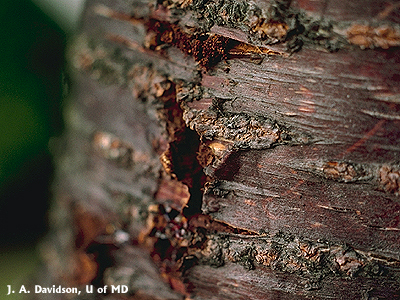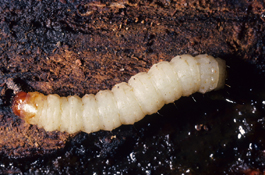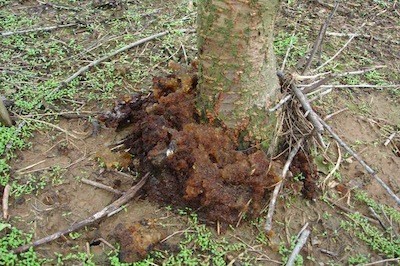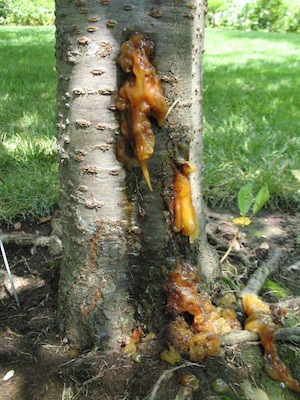The Peachtree Borer
By Elaine Pugh, Fairfax Master Gardener

male peachtree borer
The peachtree borer infects and overwinters in trees from the Prunus genus, including cherry, apricot, nectarine, plum, prune and peach varieties. This borer can girdle and kill a small tree in a single season. The best time to check for the peachtree borer is in the fall, since it may be attacking one of these trees now.
What is this pest?
This borer is Synanthedon exitiosa, a moth with four standard stages of development that looks like a wasp and has a damaging bark-chewing caterpillar.
What does the damage look like on the tree?
Borer infestations can be detected by the presence of gum with a sawdust-like frass on loose or cracked bark on the trunk from 1 to 2 feet above ground to 2 to 3 inches below ground. Younger trees are particularly susceptible, but older trees may also exhibit stunted growth, yellow foliage, wilted leaves, branch dieback and loss of productivity.

peachtree borer damage
What can we do about it in the fall?
According to the North Carolina Cooperative Extension Office, there are no effective chemicals for larvae already tunneling within the trunk or roots.
The Missouri Botanical Garden and the Utah Cooperative Extension Office recommend mechanically removing the borers in the late summer and fall by a technique called “worming” if only a few trees are infested. Individual borers may be killed by inserting a wire into their holes, but be careful not to severely damage the tree in doing this.

larvae
What does the pest look like?
The larvae are pinkish or white with a brown head, and measure from 3/5 inch to 1 inch in length. The adult is a blue-black moth with clear hind legs. The adult female is about 1 inch long and has an orange band on the abdomen. The adult male is slightly smaller and has three or four thin, yellow abdominal stripes.
What is the life-cycle?
The adult moths emerge from late June or early July and may continue until the latter part of September and sometimes in October. The adult female lays small reddish-brown eggs on the lower tree trunk, under bark scales, on rough bark or on nearby soil. The small grubs enter the trunk in the lower 12 inches of the trunk or below ground level.

female borer
The borers begin to overwinter and feed on the trunk just under the bark in the cambial tissue during the late summer and fall, gradually penetrating deeper as they develop. The overwintering larvae become active in the spring as conditions warm up. The borers pupate beginning in late May and June in cocoons located at the base of the tree or just inside their tunnels. The pupal skin is left at the base of the tree or in the soil after the adults emerge. They have one generation per year.
What can we do in the other seasons of the year? Prevention is the most effective approach but chemical controls may be required.
- Pesticides recommended for Virginia in the Pest Management Guide (PMG) include the following:

sap at tree base
Bifenthrin
Chlorantraniliprole
Esfenvalerate
Gamma-Cyhalothrin
Zela-Cypermethrin
Azadriachtin
Lambda-Cyhalothrin
Chlorantraniliprole
Piperonyl butoxide
Pyrethrins
Permethrin
Treat the trunks and soil around the base in July and repeat in five weeks. The goal is to kill the eggs/larvae before they enter the trunk. As always, read the label and follow the directions for any pesticide. - Biological controls in the PMG include Braconid and Ichneumon wasps and Steinernerna carpocapsae nematodes. Pheromone traps can also be used to disrupt mating, but this is more intense and usually used by commercial orchards.
-

gummosis from borer activity
Cultural controls in the PMG include reducing tree stress and making sure the tree is suited to the area. Avoid injuries, damage and soil compaction. Make sure infested limbs are pruned and discarded properly so emerging pests do not infest nearby plants.
What else can this be confused with?
Sap or gum exuding from the bark can also be caused by winter freeze, mechanical injury and infection by canker-causing fungi, but all of these are without the sawdust-type frass.
The Peachtree Borer attacks a number of popular trees, but early identification and future prevention of additional damage is the key to its removal.
References
• Pest Management Guide: Home Grounds and Animals, Virginia Cooperative Extension, Publication
456-018; Home Fruit: Diseases and Insects, Page 3-15 and Home Ornamentals: Insects of Trees, Shrubs,
Annuals, and Perennials Table 4-5, page 4-41
• Peachtree Borer, VCE Entomology: Insect Fact Sheets, Virginia Cooperative Extension
• Peachtree Borer, Missouri Botanical Garden
• Greater Peachtree Borer (Synanthedon exitiosa), Utah Pests Fact Sheet, ENT-103-07
• Peachtree Borer in the Landscape, North Carolina Cooperative Extension